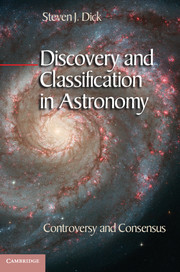Book contents
- Frontmatter
- Contents
- Preface
- Abbreviations
- Introduction The Natural History of the Heavens and the Natural History of Discovery
- Part I Entrée
- Part II Narratives of Discovery
- 2 Moons, Rings, and Asteroids
- 3 In Herschel’s Gardens
- 4 Dwarfs, Giants, and Planets (Again!)
- 5 Galaxies, Quasars, and Clusters
- Part III Patterns of Discovery
- Part IV Drivers of Discovery
- Part V The Synthesis of Discovery
- Appendix 1 Astronomy’s Three Kingdoms
- Appendix 2 Astronomical Discoveries and Their Extended Structure
- Notes
- Select Bibliographical Essay
- Glossary of Concepts Related to Discovery
- Index
2 - Moons, Rings, and Asteroids
Discovery in the Realm of the Planets
from Part II - Narratives of Discovery
Published online by Cambridge University Press: 05 August 2013
- Frontmatter
- Contents
- Preface
- Abbreviations
- Introduction The Natural History of the Heavens and the Natural History of Discovery
- Part I Entrée
- Part II Narratives of Discovery
- 2 Moons, Rings, and Asteroids
- 3 In Herschel’s Gardens
- 4 Dwarfs, Giants, and Planets (Again!)
- 5 Galaxies, Quasars, and Clusters
- Part III Patterns of Discovery
- Part IV Drivers of Discovery
- Part V The Synthesis of Discovery
- Appendix 1 Astronomy’s Three Kingdoms
- Appendix 2 Astronomical Discoveries and Their Extended Structure
- Notes
- Select Bibliographical Essay
- Glossary of Concepts Related to Discovery
- Index
Summary
Having dismissed earthly things, I applied myself to the exploration of the heavens.
Galileo, 1610If ever a discoverer was perfectly prepared to make and exploit his discovery, it was the dexterous humanist Galileo aiming his first telescope at the sky.
Heilbron, 2010I have announced this star as a comet; but the fact that the star is not accompanied by any nebulosity and that its movement is so slow and rather uniform, has caused me many times to seriously consider that perhaps it might be something better than a comet. I would be very careful, however, about making this conjecture public.
Giuseppe Piazzi, 1801With the exception of Tycho Brahe’s proof in 1577 that comets were celestial phenomena based on their parallax and thus distance, and his inference that the stella nova of 1572 was celestial based on its lack of parallax, the problem of the discovery and interpretation of new classes of astronomical objects begins substantially with Galileo and the telescopic era 400 years ago. Galileo’s telescopic observations revealed what we would today recognize as two new classes of astronomical objects: moons around Jupiter and rings around Saturn. And while Galileo and his contemporaries soon realized the nature of the moons of Jupiter by analogy to our own Moon, the story of Saturn’s rings is much more complicated.
As we shall see, both Jupiter’s moons and Saturn’s rings stand as early examples of what would become commonplace in astronomy: that “seeing” isn’t always “knowing,” that “detection” does not constitute “discovery,” that recognizing a new class of astronomical objects can be a difficult and multifaceted endeavor. In this chapter we begin to dissect the process of discovery in astronomy, in particular as it applies to the discovery of new classes of objects. We shall find it to be a complex and extended series of events consisting most often of at least three components: detection, interpretation, and understanding. This is particularly true of new classes of objects when the observer may have no idea of the true nature of the object. Again and again astronomers ran up against the unexpected in their reconnaissance of the heavens. Their struggle to move beyond mere detection, to enter the difficult realm of interpretation, and to seek physical understanding – often long after the original detection – is a story that has only been told piecemeal, but that deserves systematic treatment because it represents the core of astronomy and the natural history of the heavens.
- Type
- Chapter
- Information
- Discovery and Classification in AstronomyControversy and Consensus, pp. 33 - 62Publisher: Cambridge University PressPrint publication year: 2013



